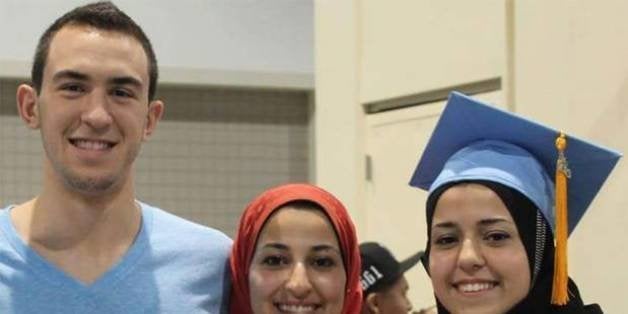
At some point during a recent debate at Stanford on a student bill that would have requested that the university divest from firms aiding in the Israeli Occupation of Palestine, a student argued against divestment because it made him feel "threatened." An audible gasp passed through the room, as we had just heard testimony from Palestinian students, one who had lost a cousin because they could not pass a checkpoint to get their medication; another whose brother was shot in the back with a bullet probably financed by US tax dollars. The news from North Carolina that came over our Twitter feeds was still only murky. But if we had known, the cry would have been much much louder. Most news agencies report the horrible deaths of three Muslims, whom some have now identified as Palestinians.
The shootings are being explained by some as having been prompted by a dispute over a parking space. There is also evidence that it was about the shooter's objection to the victims' religion. Although at this point evidence is still being sought out, it is not unlikely at all that race, ethnicity, religion, might all have played into this crime. Whatever it was, it certainly involved the three slain people being considered a problem, a threat, and to consider how it is, exactly, that people can be stripped of their humanity and reduced to simply a problem for us. An important element it this is the ways that problem can be manifested in multiple ways, big and small, direct or indirect, and how that scale shows the depth of the issue.
We need to revisit W.E.B. Dubois' famous question, "What does it feel like to be a problem?":
Between me and the other world there is ever an unasked question: unasked by some through feelings of delicacy; by others through the difficulty of rightly framing it. All, nevertheless, flutter round it. They approach me in a half-hesitant sort of way, eye me curiously or compassionately, and then, instead of saying directly, How does it feel to be a problem? they say, I know an excellent colored man in my town; or, I fought at Mechanicsville; or, Do not these Southern outrages make your blood boil? At these I smile, or am interested, or reduce the boiling to a simmer, as the occasion may require. To the real question, How does it feel to be a problem? I answer seldom a word.
Moustafa Bayoumi, in "How Does it Feel to be a Problem?: Being Young and Arab in America," adapting and updating Dubois, puts into stark relief the direct, and indirect, forms of violence and racism that people of color face. His book helps us connect direct expressions of racial violence with their less deadly and less discernible forms, and find their common source in histories of bigotry, fear, and disregard. In other words--how people become "problems," how "problems" are "solved," and the sliding scale of that problem.
Especially since 9/11 and thereafter, Arabs and Muslims have been the subject of countless acts of violence. But Bayoumi is adamant about not focusing on only the most egregious and deadly manifestations of hate. At one point in his book, Bayoumi lists of a number of instances wherein Arab-Americans and Muslims, in all sorts of public and private settings, were victims of micro-aggressions, insults, slights. He concedes that:
[It was not like] the Palestinian-American store owner in Chattanooga, Tennessee, who was shot four times in the back and killed in front of his grocery store. Or like the tragedy that befell Adel Karas, the Egyptian Coptic owner for twenty years of the International Market in San Gabriel, California. One that same day, September 15, two young men burst through the doors of his store and shot him dead. Nor was it like what happened to Waqar Hassan, a Pakistani immigrant who ran a convenience store in Dallas, Texas. On September 15, two young men burst through the doors of his store and shot him dead.
His book also points out more mundane, everyday altercations, shoving matches, insults. All point to the same repository of prejudice, disdain, and hatred.
There are of course many reasons behind this hatred, this reduction of human beings to merely the sources of our discomfort. Here I am concerned with the fact that part of what allows hatred to grow and flourish is our inability or unwillingness to allow others to speak, and to not only hear them, but listen to them as well. Too often our self-interest, and self-protectiveness, makes us feel like we know enough about "them." As Bayoumi puts it: "It seems barely an exaggeration to say that Arab and Muslim Americans are constantly talked about but almost never heard from." He connects this powerfully to racial profiling, asking, "But what exactly is a profile? It's a sketch in charcoal, the simplified contours of a face, a silhouette in black and white, a textbook description of a personality. By definition a profile draws an incomplete picture."
The media has had a lot to do with this, as scholar Evelyn Alsultany explains in her pathbreaking work, "The Arabs and Muslims in Media: Race and Representation After 9/11." It has persistently filled in that charcoal sketch with terrorists suitable only as target practice for American snipers: "The genealogy of the emergence of the Arab terrorist threat in the US commercial media reveals that while 9/11 is a new historical moment, it is also part of a longer history in which viewers have been primed by the media to equate Arabs and Muslims first with dissoluteness and patriarchy/misogyny and then with terrorism." Importantly, Alsultany not only criticizes these negative stereotypes, she also questions the positive stereotypes that again reduce Arab and Muslims to mere victims in need of saving. The issue is to clear away both these stereotypes to allow for a fuller sense of sheer human being. And to do this "we" need to step aside. One of the most powerful moments in the Stanford debate over divestment came when, one after another, Stanford senators ceded their time to allow Palestinian students to speak.
Did Craig Stephen Hicks have anti-Arab, anti-Muslim hatred in his heart as he gunned down Deah Shaddy Barakat, 23, and his wife, Yusor Mohammad, 21, of Chapel Hill, and Razan Mohammad Abu-Salha, 19? We may never know. We will never know what their lives could have become to counteract whatever dehumanizing mental process Hicks went through that allowed him to do what he did. But we can and we must stop and listen to others whose lives we too often discount and disregard. We need to see them as people, not as problems or threats.
